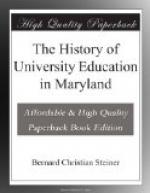To supply the want of a college, to which Baltimore boys of Roman Catholic families could go without leaving home, Loyola College was opened in September, 1852. It is under the control of the Jesuits and has confined itself to receiving day scholars.
The fifth and last Roman Catholic College, Rock Hill, was chartered in 1865.[50] It is situated near Ellicott City, as is St. Charles’s, and is under the supervision of the Brothers of the Christian Schools. It prepares youth for the various duties and occupations of life with great thoroughness, and has ever been noted especially for the attention paid to the development of the body as well as the mind of its pupils.
WESTEEN MARYLAND COLLEGE.
In 1865, Mr. Fayette R. Buell began an academy for boys and girls at Westminster, Carroll County,[51] and, in the spring of 1866, he proposed to the Conference of the Methodist Protestant Church, of which he was a member, that the school should be chartered as a college and taken under the Church’s patronage. This proposition was not acceded to, but Mr. Buell went on with his plan. Confidence in the Rev. J.T. Ward, one of the teachers in Mr. Buell’s school, induced two of his friends to lend the enterprise $10,000, and the corner-stone of the College building was laid on September 6, 1886. The College opened a year later with seventy-three pupils. In February, 1868, Mr. Buell found himself so much in debt, that he appealed to the Conference to take the property off his hands. This was done, and a Board of Trustees appointed by the Conference was incorporated by the legislature on March 30, 1868.
The next fall, the institution reopened with Rev. J.T. Ward as President, in which office he continued for seventeen years. These were years of trouble and severe work to make the College a success. There was no endowment, and only by the most strenuous efforts was the College saved on several occasions from being overwhelmed with debt. Still, in spite of all disadvantages, good work was done and valuable experience was gained. The College has been a co-educational one from the first, and connected with it was a department of Biblical Literature, for such as intended to become clergymen, until a separate Theological School was opened in 1882. During Dr. Ward’s administration, new buildings were erected and, at his resignation in 1886, he left the institution ready to be made still more efficient by his successor. Rev. Thomas H. Lewis succeeded as President and, while he has caused the work and equipment of the College to be further enlarged, he has also been successful in paying off the last dollar of the debt that had hung over it so long as an incubus.
FEMALE EDUCATION.
The Baltimore Female College, so long presided over by Dr. N.C. Brooks, was the pioneer institution in Maryland for the higher education of women. Founded in 1849, it long had a prosperous existence; but finally was obliged to close its doors in June, 1890, on account of the withdrawal of the grant formerly given by the State.




